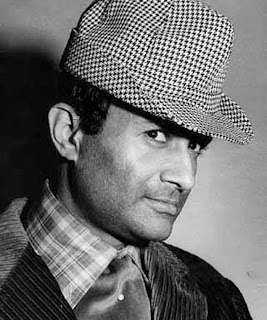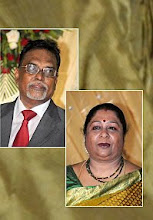Legendary actor Dev Anand passes away
"Dreams should never die. When the dreams are dead, you are dead," the actor had famously said.
While Dev Anand's mother was a pious, loving and deeply religious lady, his father was a leading lawyer of Gurdaspur, who wanted to give first grade education to all his children.
His father had a command over Persian and Arabic languages and at times he used to recite from the Islamic scriptures and explained the meaning to illiterate Muslims. At other times he used to narrate chaste Urdu poetry.
Their sister, Sheel Kanta Kapur, is the mother of renowned Hindi and English film director Shekhar Kapur.
Inset: Dev Anand (Center) with brothers Vijay (Left) and Chetan.
After graduation, he left his hometown and came to Mumbai in the early 1940's.
He began his career in the military censor office at Churchgate, Mumbai, for a salary of Rs 200.
Later, he joined his older brother Chetan as a member of the Indian People's Theatre Association (IPTA).


In a career spanning over five decades, he has received three Filmfare Awards and the Filmfare Lifetime Achievement Award in 1991.
They had a unique understanding between themselves that if one of the two becomes successful first in film industry then they would help the other to be successful so if Dev Anand produced a film, Guru Dutt would direct it and when Guru Dutt directed a film, Dev Anand would act in it.
Inset: Dev Anand's look in the film Hum Ek Hain.
Although Dev had tasted success in the films he starred in with Suraiya, the producers and directors attributed the success of these films to the acting prowess and screen presence of Suraiya.
Suraiya was always first billed star in credits implying that she was a bigger star than Dev Anand and he considered himself lucky to get a chance to star with an established actress and accepted the offers.
The relationship was affirmed during the shooting of the song Kinare Kinare Chale Jayenge from the film Vidya, where during the shoot, a boat capsized and Dev Anand ended up saving his ladylove Suraiya from drowning.
On the sets of the film Jeet, Dev Anand finally proposed to Suraiya and gave her a diamond ring worth Rs 3,000.
But as luck would have it, her maternal grandmother opposed the relationship as they were Muslim and Dev Anand Hindu, and so, Suraiya remained unmarried all her life.
Inset: Suraiya.
Mona Singh was given the screen name of Kalpana Kartik by Dev Anand's eldest brother Chetan Anand.
Her pairing with Dev was a big success at the box office and they were offered many films together. They signed all the offers and starred in Aandhiyan (1952), Taxi Driver (1954), House No. 44 (1954), and Nau Do Gyarah (1957), all of which went on to become big hits.
During the making of Taxi Driver, the couple fell in love and Dev proposed marriage to Kalpana. They married in a secret ceremony in 1954 and the couple have two children —a son, Suneil and a daughter Devina.
After her marriage, Kalpana Kartik decided not to pursue her acting career.
Apart from his pairing with Suraiya and Kalpana Kartik, his pair with Nutan and Waheeda Rehman was popular among the audiences in late 50's and 60's. His films Rahee and Aandhiyaan, were screened along with Raj Kapoor's Awaara.
Photo 16 of 26 Guide was his first film in colour and was based on the R. K. Narayan's novel of the same name.Dev Anand was instrumental in making the film version of the book as he met and persuaded Narayan to give his assent to the project. |
Photo 17 of 26 The film was directed by younger brother Vijay Anand and was a runaway success at the Box Office. Dev Anand played the role of Raju, a verbose guide, who supports Rosy (Waheeda) in her bid for freedom while grappling with his emotions in his passage through love, shame and salvation. But while being supportive, he is not above exploiting her for personal gains.Combining style with substance, he gave an telling performance, which is still remembered as one of his best. The novel story alongwith SD Burman's haunting music made it one of the masterpieces of Indian cinema. Later, a 120-minute US version of the film was made with additional directing and writing, which was produced by Tad Danielewski. The film was screened at the Cannes Film Festival in 2007, about 42 years after its release. |
In the film, Dev was paired opposite Hema Malini was a big hit. The movie also made Hema Malini a big star.
Be it his rapid-fire style of dialogue delivery or a penchant for nodding while speaking, Dev Anand's style got cult status with films like House No 44, Pocket Maar, Munimji, Funtoosh, C.I.D. and Paying Guest.
His directorial debut, the espionage drama film Prem Pujaari, was a disaster at the Box Office but has developed a cult following over the years. However, he tasted success with his 1971 film, Hare Rama Hare Krishna, which talked about the rampant hippie culture. His find Zeenat Aman, who played the mini-skirt sporting, pot-smoking Janice, became an overnight sensation.
Dev Anand, since then, became known as a filmmaker of trenchantly topical themes. That year, he starred with Mumtaz in Tere Mere Sapne, an adaptation of A. J. Cronin's novel, The Citadel. The film was directed by Dev's brother, Vijay and was also successful.
"Whenever and wherever she was talked about glowingly, I loved it. And whenever and wherever I was discussed in the same vein, she was jubilant. In the subconscious, we had become emotionally attached to each other.
"After the premiere of Ishq Ishq Ishq at Metro cinema, Raj Kapoor kissed Zeenat in full view of the invited audience, congratulating her for her sparkling performance in the film. That must have made her evening all the more sparkling. Again I felt proud of her, as much as I admired Raj Kapoor for his honest and spontaneous reaction. Complimenting her was indirectly complimenting her mentor, and I inwardly saluted my contemporary filmmaker for his sound judgement. Yet, I was jealous of him for making advances on what I considered my sole possession, my discovery, my leading lady, and desiring her with a kiss," the star confessed in his book
Even though Raj Kapoor was younger than Dev Anand, he started getting plump and this affected his career as a hero and even Dilip Kumar's films started flopping in the late sixties. But Dev Anand, fit as ever, continued to look much younger even in the late sixties and seventies and gave popular films till 1990 as the leading man.
Labels: Cinema/ Hindi, Personality

























0 Comments:
Post a Comment
<< Home